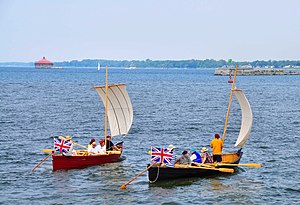Batteau
 |
|
| Class overview | |
|---|---|
| Builders: | various |
| Operators: | commercial and military freight haulers |
| In service: | c. 1650 – c. 1850 |
| General characteristics | |
| Type: | Bateau |
| Length: | 24 to 50 ft (7.3 to 15.2 m) |
| Beam: | 5 to 8 ft (1.5 to 2.4 m) |
| Draught: | up to 1 ft (0.30 m) when loaded |
| Propulsion: | setting poles, oars or sail |
| Speed: | varied |
| Capacity: | 1 to 2 tons |
| Complement: | usually 3 or more |
| Armament: | none |
| Notes: | built to ferry freight on interior waterways of North America during the seventeenth and eighteenth centuries |
A bateau or batteau is a shallow-draft, flat-bottomed boat which was used extensively across North America, especially in the colonial period and in the fur trade. It was traditionally pointed at both ends but came in a wide variety of sizes. The name derives from the French word, bateau, which is simply the word for boat and the plural, bateaux, follows the French, an unusual construction for an English plural. In the southern United States, the term is still used to refer to flat-bottomed boats, including those elsewhere called jon boats.
Bateaux were flat-bottomed and double-ended. They were built with heavy stems at bow and stern and a series of frames amidships, likely from natural oak crooks when available, and planked with sawn boards, likely pine although builders would have used whatever material was available. These boats would have varied from place to place, from builder to builder and also evolved over time, however in general, they were 24 to 50 feet (7.3 to 15.2 m) long and 5 to 8 feet (1.5 to 2.4 m) wide. The bottoms were planked and flat, without a keel, but possibly with a larger "keel-plank" in the center and sometimes reinforced with cross cleats. The sides were planked, tapering to sharp at either end.
The French explorers of North America used batteaux as well as the native canoes and cartols. The boats' shallow draft worked well in rivers while its flat bottom profile allowed heavy loading of cargoes and provided stability. The smallest batteau required only one crewman, while larger ones required up to five and reach up to 45–58 feet (14–18 meters) in length. The largest batteaux could carry two to ten tons of cargo. Batteaux could mount a small sail although the flat bottom was not optimal for sailing. In military records, it is seen that the boats were propelled primarily by oars with one oar being used at the stern as a rudder. Of Louisiana in 1763 it was described: "Beyond the mouth of the Missouri river the bateau of no prying New Orleans trader had ever penetrated." The same author wrote of the Roanoke Valley, Virginia: "One may make a pleasant voyage on the New River from this point to Eggleston's Springs, twenty-five miles further down the current, taking one of the many bateaux which ply constantly on the stream, and simply drifting on the lazy wave until the destination is reached." In the same book, the spelling is given as "batteaux":
...
Wikipedia
